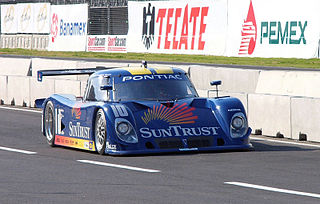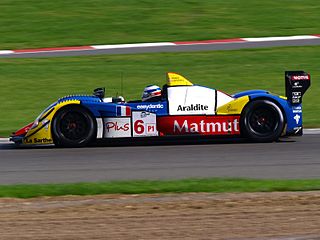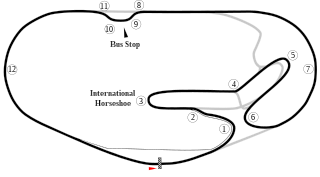Related Research Articles

BMW has been involved in Formula One in a number of capacities since the inauguration of the World Drivers' Championship in 1950. The company entered occasional races in the 1950s and 1960s, before building the BMW M12/13 inline-four turbocharged engine in the 1980s. This engine was the result of a deal between BMW and Brabham, which resulted in the team's chassis being powered by BMW engines from 1982 until 1987, a period in which Nelson Piquet won the 1983 championship driving a Brabham BT52-BMW. BMW also supplied the M12/13 on a customer basis to the ATS, Arrows, Benetton and Ligier teams during this period, with various degrees of success. In 1988, Brabham temporarily withdrew from the sport and BMW withdrew its official backing from the engines, which were still used by the Arrows team under the Megatron badge. Turbocharged engines were banned by the revised Formula One Technical Regulations for 1989, rendering the M12/13 obsolete.

Throughout its history, BMW cars and motorcycles have been successful in a range of motorsport activities. Apart from the factory efforts, many privateer teams enter BMW road cars in touring car racing. BMW also entered cars or provided engines in Formula One, Formula Two and sportscar racing. BMW is currently active in IMSA, the Isle of Man TT, the North West 200, the Superbike World Championship and the Deutsche Tourenwagen Masters.

The Sauber C9 is a Group C prototype race car introduced in 1987 as a continuation of the partnership between Sauber as a constructor and Mercedes-Benz as an engine builder for the World Sportscar Championship. The C9 replaced the Sauber C8.
Sauber Motorsport AG is a Swiss motorsport engineering company. It was founded in 1970 by Peter Sauber, who progressed through hillclimbing and the World Sportscar Championship to reach Formula One in 1993. After operating it under their own name from 1993 until 2018, Sauber Motorsport AG renamed their Formula One racing team to Alfa Romeo Racing.

Riley Technologies LLC is an American auto racing constructor and team specializing in the design and manufacture of complete race cars, as well as prototype development for racing and manufacturing applications.

The Toyota TS010 was a Group C racing car built by Toyota for the Sportscar World Championship, All Japan Sports Prototype Championship, and the 24 Hours of Le Mans.

Courage Compétition was a racing team and chassis constructor company now owned by Oreca, based in Le Mans, France near the Circuit de la Sarthe. It was founded by Yves Courage, a French race driver who ran hillclimbs before founding the company. Following the purchase of Courage by Oreca in 2007, Yves Courage has refounded the company as Courage Technology in 2010, attempting to develop electric racing cars.
The 1984 World Sportscar Championship season was the 32nd season of FIA "World Sportscar Championship" motor racing. It featured the 1984 FIA World Endurance Championship, which was open to FIA Group C1, Group C2 and Group B cars and to IMSA GTP, GTX, GTO and GTU cars. The championship was contested over an eleven race series which ran from 23 April to 2 December 1984.

The Sauber C8 was a Group C prototype race car introduced in 1985 for the 24 Hours of Le Mans as the first in a partnership between Sauber and Mercedes-Benz.

The Sauber SHS C6 was a Group C prototype racing car built by Swiss manufacturer Sauber and engineering firm Seger & Hoffman, intended for competition in the World Endurance Championship and Deutsche Rennsport Meisterschaft series. Seger & Hoffman left the project later in 1982, leaving the car completely under Sauber's control.

Spice Engineering was a British racing team founded by driver Gordon Spice with Raymond Bellm in the early 1980s, later becoming a successful sports car constructor in 1986. They competed in the World Sportscar Championship in Europe as well as the IMSA GT Championship in North America, at times partnering with major manufacturers such as General Motors and Honda as well as race engine manufacturer Comptech.
Italian motor manufacturer Alfa Romeo has participated many times in Formula One. It currently participates as Alfa Romeo F1 Team Orlen while being operated by Sauber Motorsport AG. The brand has competed in motor racing as both a constructor and engine supplier sporadically between 1950 and 1987, and later as a commercial partner since 2015. The company's works drivers won the first two World Drivers' Championships in the pre-war Alfetta: Nino Farina in 1950 and Juan Manuel Fangio in 1951. Following these successes, Alfa Romeo withdrew from Formula One.

The Lola T92/10 was a Group C sports car developed by Lola Cars as a customer chassis for the 1992 World Sportscar Championship season. It would be the final sports car built by Lola until their return in 1998.

Brun Motorsport GmbH was a Swiss auto racing team founded by driver Walter Brun in 1983. They competed as a Porsche privateer team in sports car racing for their entire existence, running in a multitude of international championships. They notably won the World Sportscar Championship in 1986 and later became a full-fledged chassis constructor. Brun was also briefly part of the EuroBrun Formula One team from 1988 to 1990. The team was eventually dissolved in 1992.

The Riley & Scott Mark III was a sports prototype auto racing car developed by Bob Riley, Bill Riley, and Mark Scott of Riley & Scott Cars Inc. Initially designed in 1993, the car was created for the World Sports Car (WSC) category which was to debut in the North American IMSA GT Championship during their 1994 season. It was not until 1995 that the first Mk III was completed, but the construction of further cars allowed a variety of teams to campaign in several North American and European racing series, including competing at the 24 Hours of Le Mans.

Luiz Felipe de Oliveira Nasr is a Brazilian racing driver. He is the 2018 IMSA Sportscar champion and won the 2019 12 Hours of Sebring.
The 2014 IMSA Tudor United SportsCar Championship (TUSC) was the inaugural season of the International Motor Sports Association's new series created out of a merger of the Rolex Sports Car Series and the American Le Mans Series and the first to be held under the name as the Tudor United SportsCar Championship. It began with the 24 Hours of Daytona, the first time since the 1997 IMSA GT Championship season that IMSA sanctioned an event at Daytona International Speedway on 25 January and ended on 4 October at Petit Le Mans. It was the 44th overall season of IMSA GT championship racing tracing its lineage to the 1971 IMSA GT Championship.
Martino Finotto was an Italian racing driver, mainly known for his success in touring car and sports car racing.

The March 86G was a Group C and IMSA GTP sports racing car built by March Engineering. Built as simply a chassis with no engine, it was branded as one of three cars, the BMW GTP, the Buick Hawk or the Nissan R86V depending on which engine was placed in the chassis and which team was running it. There were a number of subtle bodywork changes to reflect the manufacturer which ran the car.

The 2022 24 Hours of Daytona was an endurance sports car race sanctioned by the International Motor Sports Association (IMSA). The event was held at Daytona International Speedway combined road course in Daytona Beach, Florida, on January 29–30, 2022. This event was the 60th running of the 24 Hours of Daytona since its inception in 1962, and the first of 12 races across multiple classes in the 2022 IMSA SportsCar Championship, as well as the first of four rounds in the 2022 Michelin Endurance Cup. The #60 Meyer Shank Racing Acura, driven by Tom Blomqvist, Hélio Castroneves, Oliver Jarvis, Simon Pagenaud, took the overall win in one of the most competitive events in race history. The top four overall finishers led for at least 88 laps each. Despite being fourth with around three hours left in the race, a monster stretch from Blomqvist helped his team assume the lead before giving way to Castroneves. Castroneves held off former teammate and two-time champion Ricky Taylor to win his second Rolex 24 in a row. The final margin of 3.028 seconds was the third closest in race history. It was also Meyer Shank Racing's first win in IMSA since 2020.
References
- ↑ "Sauber c7 - specs, photos, videos and more on TopWorldAuto". topworldauto.com. Retrieved 2022-06-16.
- ↑ "A Golden Jubilee for Sauber Motorsport". Sauber Group. Retrieved 2022-06-16.